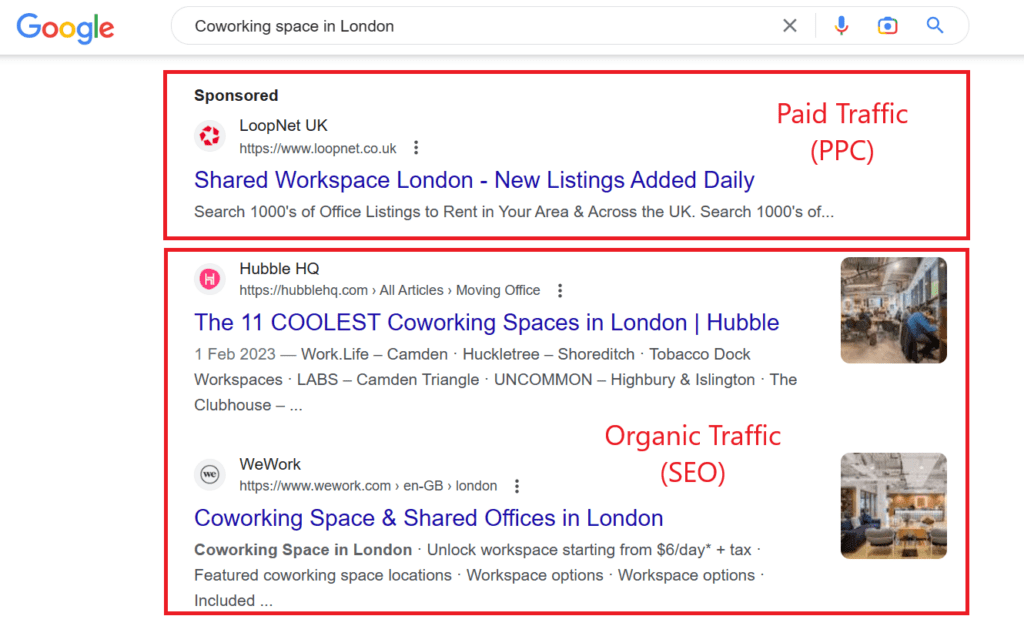During a conversation with the main partner of a 50-employee B2B company, we discussed three main problems stopping their business from growing:
- Complex and lengthy sales cycle.
- Highly competitive landscape with many vendors vying for the same clients.
- Never knowing when their next client will come and where from.
To solve these problems, the business needed to invest in marketing to attract valuable clients. Pay Per Click (PPC) is one of the best ways to do this because it helps:
- Find potential clients who are in-market for your product and/or service.
- Generates a predictable flow of new clients.
- Ensures affordability if you use the right strategies (read below).
Using our PPC strategies with 200+ businesses, we’ve generated 1000s of new customers for our clients. Read this article to learn how to find new and valuable clients through PPC, and book a call if you’d like an honest digital marketing agency to run your PPC campaign for you.
How much profit can PPC make your B2B company?
It’s very likely one of your competitors is growing rapidly as a result of a well-executed PPC strategy.

But every B2B company is different. Your business will have different positioning, brand awareness, service offering, and costs compared to a local competitor. That is why you need to have a suitable strategy for your B2B offer.
Therefore, before you read our winning strategy, it is essential that, with our interactive calculator, you should first work out if PPC will be a profitable method to acquire new clients.
But first, read these three definitions to understand how the calculator works!
How PPC Works
When you run a PPC campaign, you will pay to appear on a search engine every time a potential client searches a specific keyword (which we will define later). Every time a potential client clicks on your ad, you will pay money to the ad platform. This is called the Cost Per Click (CPC). For the B2B industry, CPCs typically range from $1 and $5.
|
Cost Per Click (CPC) Cost per click is the amount of money you pay to an advertising platform, like Google, to have a user click on your ad. |
Of the people who click on your ad, some will convert into becoming a client. This is your Conversion Rate (CVR). For the B2B industry, CVR typically range from 1% and 5%.
|
Conversion Rate (CVR) Conversion rate is the percentage of users that convert into becoming a customer after clicking your ad. |
We can use this to determine the cost of acquiring a single client. Typically, this is called the Customer Acquisition Cost (CAC). For the B2B industry, CACs typically range from $0.2 and $5.
|
Customer Acquisition Cost (CAC) This is the cost of acquiring a single customer or client. Customer Acquisition Cost = Cost Per Click / Conversion Rate CAC = CPC / CVR |
Interactive PPC Profit Calculator
Use this interactive calculator to work out how much profit you will receive from each client acquired through PPC.
We’ve built this calculator using typical CPC and CVR across the B2B industry. All you need to do is enter the amount of revenue a single client generates for you. The calculator then subtracts the marketing costs from the revenue to give you a profit per client. Hence, by using this calculator, you can develop an understanding of the potential profits PPC could generate for your business.
It is important to note that PPC is not 100% predictable, so we have created three unique cases which represent how well your PPC campaign could perform.
Enter how much a single client
generates you in revenue
| best | average | worst | |
|---|---|---|---|
| CPC | |||
| CVR | |||
| CAC | |||
| Profit |
Visualise how much profit you could make with PPC
Overview of our PPC strategy
There are three steps to running a profitable PPC strategy.
- Set up PPC campaigns correctly to target the right audience and keywords.
- Design high-converting landing pages. These are the pages that your potential clients will visit.
- Optimise your ads and landing pages to get the maximum profit.

Paid Search + Paid Social
We create and manage ad campaigns on all search and social platforms.

Landing Page Design
We design and implement landing pages that are made to convert.

Conversion Optimization
We perform ongoing analysis and experimentation to optimize performance.
Without experience, a lot can go wrong. Doing even one of the steps incorrectly can result in losing money for every single client you acquire.
That’s because choosing the wrong keywords can result in you paying a massive $200 per click, not a mere $20. It can result in your page converting at a lowly 2%, not an optimised 20%. It’s the difference between you paying $100 for every new client or an unprofitable $10,000.
To not lose money and grow your business profitably, it is important to get each step right. The rest of the article will shed light on how to achieve a profitable PPC campaign.
Should you run ads on paid search or paid social?
There are two ways to advertise your B2B solution online:
- Paid Search (Google Ads, Bing Ads)
- Paid Social (Facebook, TikTok, Instagram, Snapchat)
What’s the difference? Paid Search is when your ad appears on a search engine, like Google, after you’ve searched a term. This is a very powerful advertising method because you can choose what keywords your business appears for.
We know which keywords potential clients use when looking for a B2B solution. So, we can specifically choose to show your business at the top of Google for those keywords. But because of this amazing feature, your competitors will try a similar strategy and make it expensive. You’ll need to optimise all parts of your PPC strategy to ensure costs don’t spiral upwards!
On the other hand, if you use Paid Social, you appear ‘in-feed’. When someone is scrolling on a platform like Facebook or Instagram, ads appear. These ads interrupt the scrolling process. The person scrolling has not said they’re interested in your B2B offer, but you’re hoping your ad will attract a client. The disadvantage of this technique is your ad is also shown to people who don’t need your services. On the other hand, this advertising method is cheaper.
We’ve mostly seen B2B brands generate more profit on Paid Search, but there are some cases when Paid Social can work very well.
Hence, it’s not completely black and white which way of advertising will work best for your business. It depends on the following:
- What exact B2B service or product are you selling?
- Who are your target clients?
- Where do your clients spend their time online?
- How much money do you make per client?
We’re going to discuss Paid Search in this article as it is the most profitable PPC strategy when starting off. Also, sometimes a hybrid strategy using Paid Social can improve effectiveness — if this is something you’d like to discuss, you can book a call.
Running PPC paid search ads
The most common paid search ads are keyword based. When a keyword is searched, ads appear at the top of Google.
For example, here’s a generic keyword ‘Coworking Space in London’. Notice how the PPC ads appear first, and then the organic results (from SEO) appear second.

By paying for this ad, you can appear above SEO results (which takes longer to achieve). But, there are some pros and cons to this.
Pros of PPC:
- You can get in front of your potential clients quickly.
- You can win valuable clients.
- You can test which keywords bring in qualified clients.
Cons of PPC:
- It can be expensive if you don’t set it up right.
- Most people scroll straight past your ads. They prefer to look at SEO/organic results (however, we can help you counter this by running a hybrid strategy so you appear for both).
Up till now, you’ve learnt and understood:
- How PPC works
- If PPC will generate profitable clients
- What paid search is
- The pros and cons of a PPC strategy
However, we mentioned that PPC could sometimes be expensive if you go for the wrong keyword. How do you know which keywords will make you money? Let’s explore this further.
Which PPC keywords should you target to get new clients?
Most inexperienced PPC managers will make the mistake of choosing the wrong keywords. That mistake alone can be the difference between swimming in 10 new clients or drowning in $1000s of debt.
Here’s what wrong keywords look like:
Firstly, the wrong keywords are based exactly on the service you offer. Initially, it may seem perfect, but it can have an adverse impact.
Let’s take the example of the keyword, ‘CRM system’. There are many competitors bidding for the exact keyword. This means the CPC is higher than is profitable for you to pay for, and results in you losing money. Remember, PPC operates on an auction-based bidding model. That means the more competitors that want to appear for the keyword, the more you pay.
Secondly, the wrong keywords have low intent.
For example, ‘what is a CRM system?’. The person Googling that keyword is not ready to engage with your service. They’re in education mode. Typically, these keywords have a very low CPC because no one wants that traffic.
But what do the right keywords look like?
Firstly, the right keywords that have a high intent to purchase services and receive a quote. For example, these could be branded, product, or pain point keywords.
Secondly, the right keywords have reasonable CPCs, which make sense for the services you sell. You can look back at our interactive calculator to figure that out.
We’re going to show you all the types of keywords that can result in a lot of profit for your B2B company.
| Type of keyword | Examples of keyword | Pros | Cons |
| Branded | HubSpot WeWork Mailchimp Amazon |
Cost-effective strategy to win new clients when your competitors may not be the best servicer. | The competition usually bids on their own branded keyword to protect against it. |
| Product/service | CRM system Task management software High-quality video conferencing |
High intent keywords for purchase or solving pain point and can be very profitable. | Service-level keywords are usually competitive, and services need bespoke landing pages. |
| Location | Coworking office in New York Fulfilment centres in the UK Corporate event planner in East London |
High intent and very cost-effective. The big competitors usually avoid these keywords. |
You’ll be competing with local providers. You’ll need to be locally present or have easy ‘contact us’ information. |
| Pain point | How to improve workflow efficiency? How to plan a corporate event How can self-employed individuals network? |
It is possible to capture this lead before they go to competitors. You’ll be able to close this client without competition. |
Slightly lower buying intent as the user is in education mode. Will need a well-designed landing page. |
Excellent PPC ad creative and copywriting examples
Your ads appear next to your competitors, so you have to find a way to stand out. That is why we first analyse the competitive landscape before bidding on a keyword for a client.
Here are some examples of B2B-related ads and what we think of them.
Ad 1: HubSpot appearing for ‘Free CRM Software’

Keyword: ‘Free CRM Software’
Verdict: 5/5
Good areas: Excellent headline. It contains the keywords from the search and offers a compelling ‘Unlimited Users & 1M Contacts’ Offer. Also offers great CTA in the link extensions.
Bad areas: The ad could go one step further by offering some social proof, such as 5-star reviews or the number of users.
Ad 2: Asana appearing for ‘Task Management Tools’

Keyword: ‘Task Management Tools’
Verdict: ⅘
Good areas: Headline features the keyword. The ad highlights the solution of organisation and team communication.
Bad areas: There isn’t a clear CTA to encourage a click.
Ad 3: Easy Offices appearing for ‘Coworking Spaces UK’

Keyword: ‘Coworking Spaces UK’
Verdict: ¾
Good areas: Highlights USPs in the description, including suiting ‘All Sizes And Budgets.’
Bad areas: It should be more specific to the search query by mentioning UK locations. There isn’t a direct CTA and the description cuts off.
Ad 4: Sendible appearing for ‘Social Media Scheduling Tools’

Keyword: ‘Social Media Scheduling Tools’
Verdict: ⅘
Good areas: The headline is great. It uses the keywords in the search query and offers an enticing way to ‘Plan, Post, & Measure’ the user’s content.
Bad areas: The term ‘Best’ is subjective and could be backed up by social proof such as reviews or press mentions. This ad also needs a compelling CTA.
Ad 5: ShipBob appearing for ‘Eco-Friendly Fulfilment’

Keyword: ‘Eco-Friendly Fulfilment’
Verdict: ⅗
Good areas: Good display of features and benefits, including great social proof in the description. Good use of link extensions to direct the searcher to the right page.
Bad areas: The headline could include the full keyword or a variation of it. There is no mention of ‘eco-friendly’ or similar terms, so competitors will stand out here.
How to create a high-converting landing page for B2B PPC?
A high-converting landing page is one of the biggest factors in PPC success. Without it, you’ll be paying for traffic that doesn’t convert into clients. That’s a huge waste of cash!
We recommend you have a conversion rate expert build out your landing page. Our winning landing page framework is reserved for our clients, but we’ll reveal the most important sections you need.
Hero Block
The first section of the landing page is called the ‘Hero Block’. You can see the whole section as soon as you open the web page. You need to have three things in this section:
- Great headline. For example, ‘CRM Management System Trusted By Over 1M+ Users’
- Social proof. For example, 5.8/5 stars, 4,000+ reviews
- Call to action. For example, ‘Start Your Free Trial Today’
Your hero block needs to simply call out exactly what you offer, who it is for, and why you are a low-risk solution.
Service Block
High up the page, probably in the 2nd or 3rd block, you will need to explain your services and/or products. You should explain its features and benefits. For example, if you provide contrast renewal and negotiation services, you would have features and benefits as follows:
Features:
- Comprehensive legal review of contracts
- Skilled negotiation of contract terms
- Personalised approach tailored to your business needs
Benefits:
- Minimise legal risks and avoid costly disputes
- Secure favourable terms and protect your business interests
- Save time and resources by outsourcing to legal experts
Call to Action Block
Every PPC landing page needs a highly compelling call to action block. It is solely designed to get the user to fill in a form, book a call, or purchase your product.
We highly suggest including several call-to-action blocks throughout your landing page, such as at the top of your page, one in the middle of your page, and one at the end. You’ll be surprised how much it can increase your conversion rates and reduce your customer acquisition costs!
We include 6+ other high-converting blocks in our landing pages. Reach out to learn what they are and how to implement them.
Engage an agency to run your PPC ads
There are lots of aspects to running a profitable PPC campaign for your B2B company. You can attempt it yourself, or you can engage us, NUOPTIMA. We’ve worked with 200+ businesses and run thousands of PPC campaigns profitably.
A bit about us
We’re an honest growth agency, and our goal is to drive profit for your business.
We don’t work with everyone. In fact, we actively refuse 50% of all businesses that try to work with us. That’s purely based on if we think we can make your campaign a success. We only grow as an agency if we can get you results and you refer us to your friends and family.
Before you choose a PPC agency, reach out to our team. We’ll objectively tell you what we think, and if it’s good, we’ll propose a fair price alongside a set of growth expectations and Key Performance Indicators (KPIs).
Once you start to work with us, you’ll be in regular contact with our team. You’ll be provided with extensive data tracking and will communicate with us on regular calls.
Our PPC capabilities:
- We can service budgets from $100+ ad spend per day.
- Management costs start from $1,000 per month, depending on ad spend, platform, and requirements.
- Work on all ad platforms: Google, Facebook, Tiktok, Snapchat, and Reddit.
- We’ve worked with local service providers to public companies.
- We’ve worked across B2C and B2B, having driven brands to 7 figures in sales, and exceeded B2B SQL quotas.
Next steps:
- Firstly, you should visit our PPC services page here.
- Then, you should read through some case studies here.
- And when you’re ready, send us a message or book a call here.
FAQ
Pay Per Click (PPC) is an advertising model that allows B2B brands to market their solution to potential clients when they are ready to purchase. As the name suggests, you only pay for the ad when someone clicks on your ad.
It’s essential to identify the right keywords to ensure your ad is positioned in front of qualified leads. Moreover, you should ensure your landing page is relevant to the ad to prevent the clicker from leaving your page.
Search Engine Optimisations (SEO) and PPC are two excellent B2B marketing methods. PPC offers a quick way to get in front of your potential clients when they are ready to purchase; however, you must use the right strategies to ensure affordability. In contrast, SEO is better for long-term growth. Get in touch today and our team will help you find the best method for your B2B brand.


